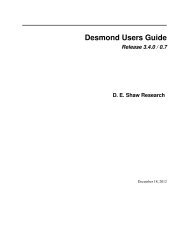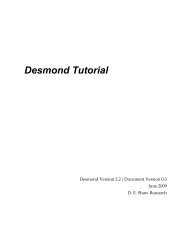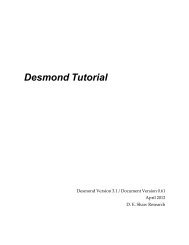Desmond Tutorial
Desmond Tutorial - DE Shaw Research
Desmond Tutorial - DE Shaw Research
- No tags were found...
You also want an ePaper? Increase the reach of your titles
YUMPU automatically turns print PDFs into web optimized ePapers that Google loves.
<strong>Desmond</strong> <strong>Tutorial</strong><br />
<strong>Tutorial</strong> Steps<br />
11. Click Preprocess to execute the first phase of the protein preparation tasks. The Analyze<br />
only button simply fills the tables in the wizard panel, but changes are not applied to<br />
the structure.<br />
Setup takes only a few seconds to complete. The Protein Preparation Wizard displays<br />
the chains, waters, and het groups as shown in Figure 1.8.<br />
Figure 1.8 Protein Preparation Wizard — Preprocessing stage<br />
Double-click<br />
the ‘Display Only<br />
Selected Atoms’<br />
button to show<br />
the added<br />
hydrogen atoms.<br />
Residue chains<br />
and water<br />
molecules are<br />
listed here.<br />
HET groups (if<br />
any) are listed<br />
in this table.<br />
As shown, the top table lists residue chains and water molecules, and the bottom table<br />
lists HET groups such as metal ions, enzyme cofactors, ligands, and so on (in this<br />
example this table is empty).<br />
The added hydrogen atoms are not shown by default. To display them, double‐click<br />
the Display Only Selected Atoms button as shown in Figure 1.8. You can also use the<br />
options in the Protein Preparation Wizard panel to display hydrogen atoms. Also note<br />
that the added capping groups can be seen in the circled area, shown in wire frame<br />
representation.<br />
You can select any item in the table by clicking its row as shown in Figure 1.9. Notice<br />
that when you select an item in the table, the Workspace view focuses on the selection<br />
and highlights it with a contrasting color scheme; hydrogen bonds are also displayed.<br />
Use CTRL‐Click to return to the original view. On Figure 1.9 a single water molecule<br />
is selected, which is shown with the red oxygen atom in the middle of the Maestro<br />
Workspace.<br />
September 2008 D. E. Shaw Research 9






